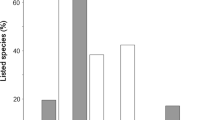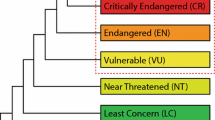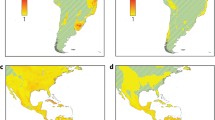Abstract
The Global Strategy for Plant Conservation calls for a preliminary assessment of the conservation status of all known plant species by the year 2010. To date insufficient progress has been made on meeting this target. New efforts to develop a preliminary list beyond using the full IUCN criteria in plant assessments are needed. Here we present an algorithm that provides a preliminary assessment of the conservation status of plant species using data from herbarium specimens. We use Hawaiian specimen data from the United States National Herbarium to calibrate the parameters of the algorithm and then use specimen data from the Arecaceae, Commelinaceae, Gesneriaceae and Heliconiaceae as examples of the application of the algorithm. The algorithm was calibrated to insure 95% accuracy in placing the Hawaiian plant species into previously and independently determined threatened categories. Our results indicate that 28% of the Hawaiian taxa, 27% of the species of Arecaceae, 45% of the species of Commelinaceae, 32% of the species of Gesneriaceae, and 35% of the species of Heliconiaceae are Not Threatened and will not need any further evaluation for the preliminary assessment. Species identified here as Potentially Extinct and Potentially Threatened can be further assessed by additional herbarium material and/or conservation specialists for final evaluation using other assessment strategies (e.g., regional and national lists, taxonomic expert assessment, etc.).



Similar content being viewed by others
References
Burgman M, Grimson R, Ferson S (1995) Inferring threat from scientific collections. Conserv Biol 9:923–928. doi:10.1046/j.1523-1739.1995.09040923.x
Case MA, Flinn KM, Jancaitis J, Alley A, Paxton A (2007) Declining abundance of American ginseng (Panax quinquefolius L.) documented by herbarium specimens. Biol Conserv 134:22–30. doi:10.1016/j.biocon.2006.07.018
Chapin MH, Wood KR, Perlman SP, Maunder M (2004) A review of the conservation status of the endemic Pritchardia palms of Hawaii. Oryx 38:273–281. doi:10.1017/S003060530400050X
Golding JS (2004) The use of specimen information influences the outcomes of Red List assessments: the case of southern African plant specimens. Biodivers Conserv 13:773–780. doi:10.1023/B:BIOC.0000011725.78505.07
Govaerts R (2001) How many species of seed plants are there? Taxon 50:1085–1090. doi:10.2307/1224723
GSPC (2002) Global strategy for plant conservation. Convention on Biological Diversity, Montreal
Hedenäs L, Bisang I, Tehler A, Hamnede M, Jaederfelt K, Odelvik G (2002) A herbarium-based method for estimates of temporal frequency changes: mosses in Sweden. Biol Conserv 105:321–331. doi:10.1016/S0006-3207(01)00212-9
Hernández HM, Navarro M (2007) A new method to estimate areas of occupancy using herbarium data. Biodivers Conserv 16:2457–2470. doi:10.1007/s10531-006-9134-6
Holmgren PK, Holmgren NH (1998 and continuously updated) Index Herbariorum: a global directory of public herbaria and associated staff. New York Botanical Garden’s Virtual Herbarium [http://sweetgum.nybg.org/ih/, accessed 8 September 2008]
IUCN (1994) IUCN Red List categories and criteria: version 2.3. IUCN Species Survival Commission, Gland, Cambridge
IUCN (2001) IUCN Red List categories and criteria: version 3.1. IUCN Species Survival Commission, Gland, Cambridge
IUCN (2008) 2007 IUCN Red List of threatened species. IUCN, Gland, Switzerland [http://www.redlist.org, accessed 8 September 2008]
Johnson D (ed), The IUCN/SSC Palm Specialist Group (1996) Palms: their conservation and sustained utilization. Status survey and conservation action plan. IUCN, Switzerland
Kress WJ, Krupnick GA (2005) Conclusion: documenting and conserving plant diversity in the future. In: Krupnick GA, Kress WJ (eds) Plant conservation: a natural history approach. University of Chicago Press, Chicago
Kress WJ, Betancur J, Echeverry B (1999) Heliconias—Llamaradas De La Selva Colombiana. Cristina Uribe Editores, Bogotá
Kress WJ, DeFilipps RA, Farr E, Daw Yin Yin Kyi (2003) A checklist of the trees, shrubs, herbs and climbers of Myanmar (Revised from the original works by J.H. Lace and H.G. Hundley). Contrib US Natl Herb 45:1–590
Krupnick GA, Kress WJ (2005) Plant conservation: a natural history approach. University of Chicago Press, Chicago
MacDougall AS, Loo JA, Clayden SR, Goltz JG, Hinds HR (1998) Defining conservation priorities for plant taxa in southeastern New Brunswick, Canada using herbarium records. Biol Conserv 86:325–338. doi:10.1016/S0006-3207(98)00031-7
Nic Lughadha E (2004) Towards a working list of all known plant species. Philos Trans R Soc Lond B 359:681–687. doi:10.1098/rstb.2003.1446
Prance GT, Beentje H, Dransfield J, Johns R (2000) The tropical flora remains undercollected. Ann Mo Bot Gard 87:67–71. doi:10.2307/2666209
Randrianasolo A, Miller JS, Consiglio TK (2002) Application of IUCN criteria and Red List categories to species of five Anacardiaceae genera in Madagascar. Biodivers Conserv 11:1289–1300. doi:10.1023/A:1016070703803
Skog LE, Boggan JK (2007) World checklist of Gesneriaceae—Department of Botany, Smithsonian Institution. http://botany.si.edu/gesneriaceae/checklist/. Cited 8 Feb 2008
Stevens PF (2001) Angiosperm phylogeny website, version 7. http://www.mobot.org/MOBOT/research/APweb/. Cited 8 Feb 2008
Strahm W (2003) Draft stakeholder consultation on Target 2: a preliminary assessment of the conservation status of all known plant species, at national, regional and international levels. Global Strategy for Plant Conservation (GSPC)
Ungricht S, Rasplus JY, Kjellberg F (2005) Extinction threat evaluation of endemic fig trees of New Caledonia: priority assessment for taxonomy and conservation with herbarium collections. Biodivers Conserv 14(1):205–232. doi:10.1007/s10531-005-5049-x
Wagner WL, Bruegmann MM, Herbst DM, Lau JQC (1999) Hawaiian vascular plants at risk: 1999. Bish Mus Occas Pap 60:1–58
Wagner WL, Herbst DR, Lorence DH (2005) Flora of the Hawaiian Islands website. http://botany.si.edu/pacificislandbiodiversity/hawaiianflora/. Cited 8 Feb 2008
Willis F, Moat J, Paton A (2003) Defining a role for herbarium data in Red List assessments: a case study of Plectranthus from eastern and southern tropical Africa. Biodivers Conserv 12:1537–1552. doi:10.1023/A:1023679329093
Zona S, Verdecia R, Sánchez AL, Lewis CE, Maunder M (2007) The conservation status of West Indian palms (Arecaceae). Oryx 41:300–305. doi:10.1017/S0030605307000404
Acknowledgments
We thank Chris Tuccinardi for assistance with each of the specimen databases; Robert Faden for assistance with the Commelinaceae specimen database; John Boggan, John L. Clark, Laurence Skog for assistance with the Gesneriaceae specimen database; and Ida Lopez for assistance with the Heliconiaceae specimen database. Brian Boom provided an informal review of an earlier version of this manuscript.
Author information
Authors and Affiliations
Corresponding author
Appendices
Appendices
Rights and permissions
About this article
Cite this article
Krupnick, G.A., Kress, W.J. & Wagner, W.L. Achieving Target 2 of the Global Strategy for Plant Conservation: building a preliminary assessment of vascular plant species using data from herbarium specimens. Biodivers Conserv 18, 1459–1474 (2009). https://doi.org/10.1007/s10531-008-9494-1
Received:
Accepted:
Published:
Issue Date:
DOI: https://doi.org/10.1007/s10531-008-9494-1




